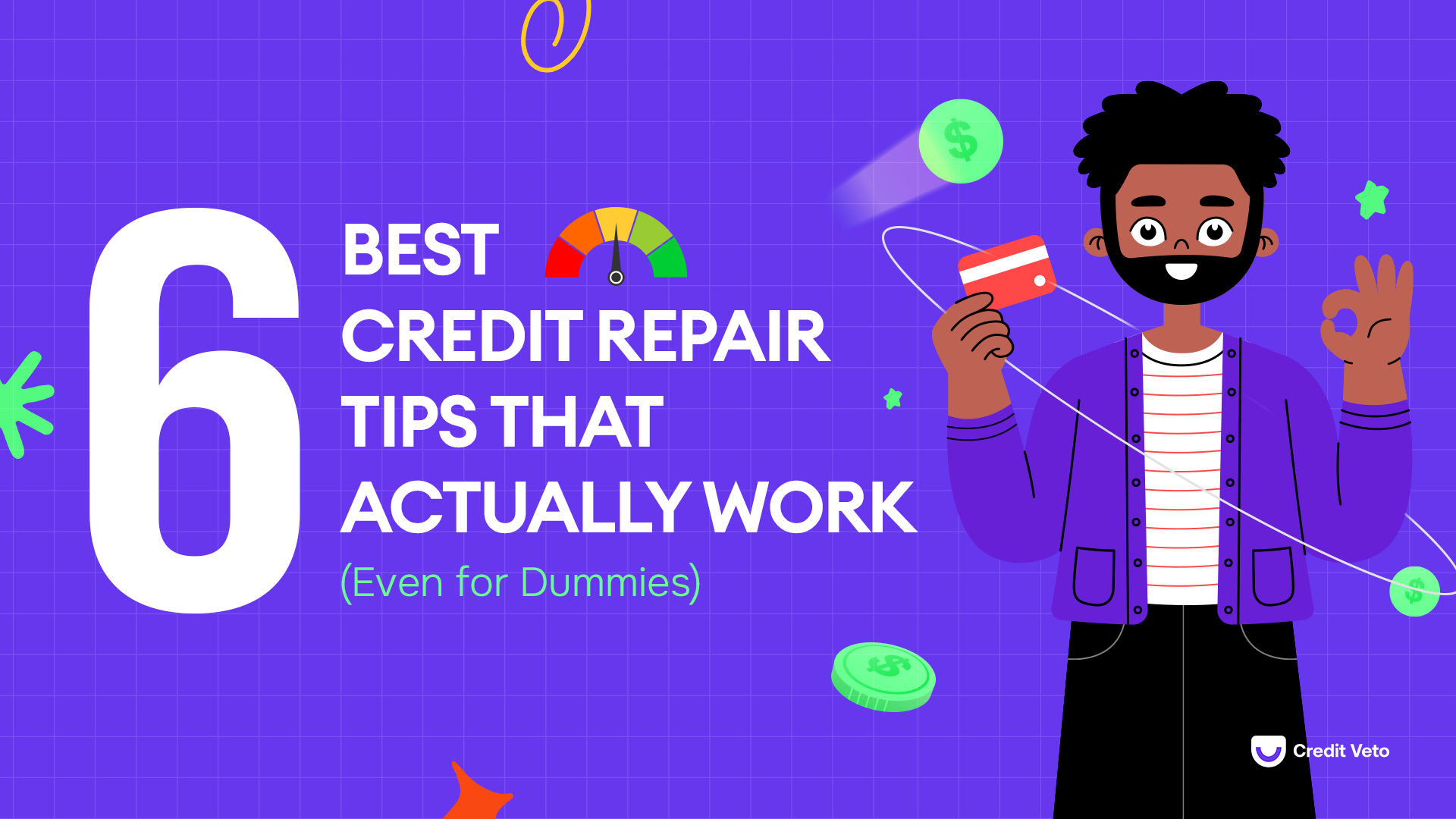The 6 Best Credit Repair Tips That Actually Work (Even for Dummies)
Tired of going around in cycles? Discover 6 proven credit repair tips that actually work. Fix your credit fast, boost your score, and take control of your financial future today.

Quick Fixes for Dummies, Smart Strategies for Everyone
Let's be real; fixing your credit can feel overwhelming, especially when you're unsure where to start. From checking confusing credit reports to persistent collection calls, the journey to better credit often seems filled with roadblocks.
But here’s the truth: Repairing your credit is 100% possible and often faster than you think. Whether you're Googling things like "quick fix credit," "fixing credit for dummies," or "5-minute credit score trick," this post is your complete guide to getting results.
If you're searching for quick-fix credit, wondering how much it costs to fix your credit, or you’re just overwhelmed by the whole idea of credit scores—this post is for you. Whether your score took a hit from missed payments, high utilization, or even bankruptcy, credit repair isn't just possible; it's powerful when done right.
Before diving into the tips, let’s break it all down.
What Exactly Is Credit Repair?
Credit repair is the process of improving or restoring a damaged credit score, often by identifying and disputing errors on your credit report and taking actionable steps to rebuild your creditworthiness.
Many people assume credit repair is about hacking the system or finding a shortcut, but it’s not. It’s about understanding the system and using legitimate, legal strategies to improve your financial standing.
There are professional services, like Credit Veto, that help individuals monitor their reports, dispute inaccuracies, and create strategic plans to rebuild and maintain strong credit.
Now, let’s get into the most effective tips to help you get started. Below, we’ll explore the six best credit repair tips that actually work, why they’re effective, and how we can help you accelerate the process
1. Regularly Monitor Your Credit Report
Think of your credit report as your financial health chart. Just like you wouldn’t ignore symptoms in your body, you shouldn’t ignore errors or activity on your credit file.
You’re entitled to one free credit report every year from each of the major credit bureaus: Experian, TransUnion, and Equifax. Use sites like AnnualCreditReport.com to access them.
Why this matters:
- 1 in 5 Americans has an error on their credit report that could hurt their score.
- Credit monitoring helps you spot identity theft early.
- You can track changes as you work on improving your score.
Pro Tip: Set reminders to check your reports every 3-4 months by rotating between bureaus. It’s free, and it keeps you in the loop.
2. Dispute Errors on Your Credit Report
One of the quickest and most effective ways to improve your score is to review your credit report for errors and dispute them. According to a Consumer Financial Protection Bureau (CFPB) study, 1 in 5 people have errors on their credit reports that could be dragging their scores down.
These errors include:
- Accounts that don’t belong to you
- Incorrect payment histories
- Duplicate debts
- incorrect balances
- Inaccurate personal information
If your report contains any of these inaccuracies, they can unfairly drag down your credit score.
Here’s how to fix it:
- Identify the error (note the account and issue).
- File a dispute with the bureau reporting the error (Equifax, Experian and TransUnion)
- Include supporting documents to prove your case.
- The bureau must respond within 30 days.
Tools like Credit Veto make this process faster by helping you monitor, identify and file disputes for inaccuracies directly and keep track of the status on your behalf while offering real-time credit tracking and support so you never miss an update.
Disputing errors can lead to a score bump within 30 days once the issue is resolved.
3. Use the Credit Utilization Hack
This is a fancy way of saying, “Don’t max out your credit cards.” Your utilization rate = your credit card balances ÷ your total credit limit. You might have seen this called the “5-minute credit score trick”—and yes, it really works.
Why This Works:
Your credit utilization ratio (the amount of available credit you’re using) accounts for 30% of your credit score. Keep it under 30%, ideally under 10% for the best scores.
Example:
If your limit is $1,000 and your balance is $800, your utilization is 80%—and that’s hurting your score. Pay it down to $100, and your credit utilization drops to 10%, giving your score a healthy boost.
Quick Fix Tip: If you can’t pay it down right away, request a higher credit limit. This lowers your utilization rate without paying anything (as long as your balance stays the same).
Some people see a score increase of 20–50 points within a month just by reducing their credit utilization.
4. Pay Every Bill On Time—Every Time
If you’re behind on payments, this is one of the most damaging factors to your score and the most important to fix.
Why This Works:
Payment history accounts for 35% of your credit score. Getting current shows lenders you’re reliable and reduces the damage of past missed payments. One missed payment can drop your score by over 100 points.
What to Do:
- Set auto-pay for minimum payments.
- Use calendar reminders for due dates.
- List all accounts where you’re past due
- Contact creditors to negotiate a repayment plan or ask to re-age the account. Some may have a grace period.
- Start making at least minimum payments consistently
Even one month of consistency can start to nudge your score upward. Don’t underestimate the compounding impact of consistent, on-time payments.
Once you’re current, your score can improve gradually over the next 1–3 months, especially if the account status changes from “delinquent” to “current.”
5. Use “Credit-Building” Tools
Fixing credit isn’t just about removing bad items, it’s about adding good ones.
Tools that help include:
- Secured Credit Cards: Great for building credit from scratch.
- Credit-Builder Loans: Offered by credit unions or online lenders.
- Become an authorized user: Piggyback off someone else’s good credit (with permission). If someone you trust has great credit, you can boost your score simply by being added to their credit card account. When you're added as an authorized user, their account history shows up on your report, even if you never use the card.
Ask a family member or friend to add you as an authorized user. Make sure their card has no late payments and low utilization. Confirm that the card issuer reports authorized users to credit bureaus. This is a powerful credit-building tactic for those with little or no credit history, and results can show up in 30–60 days.
- Experian Boost: Adds utility and phone bills to your credit history.
Credit Veto also offers AI-powered strategies that guide you to the right credit-building tools based on your unique credit profile.
6. Avoid New Hard Inquiries
Every time you apply for a credit card, loan, or even some phone plans, a hard inquiry hits your credit report. While one or two won’t do much, multiple inquiries in a short time can drop your score.
Instead:
- Prequalify without affecting your score.
- Space out applications.
- Only apply when truly necessary.
NEXT STEP: Work with a Trusted Credit Repair Service
Sometimes, you need more than DIY strategies—you need a partner. That’s where CreditVeto comes in.
Why This Works:
Professional credit repair services understand how to navigate complex credit issues, dispute accounts effectively, and guide you through score-building with real strategy.
At Credit Veto, we don’t just "fix credit"—we:
- Monitor your credit 24/7
- Dispute negative items across all three bureaus
- Build a personalized repair strategy
- Use AI tools to track changes and predict score trends
- Offer expert guidance and repair
- And lots more…
How Much Does It Cost to Fix Your Credit?
The cost of fixing your credit varies majorly from $50 to $150 per month, but Credit Veto offers affordable, transparent pricing plans, often saving you thousands in long-term interest payments and denied applications.
Frequently Asked Questions
Q: What is the 5-minute credit score trick?
A: It usually refers to:
- Paying down a balance before the statement date
- Becoming an authorized user
- Disputing an error Each of these can quickly boost your score if done right.
Q: How much does it cost to fix your credit?
A: DIY? Free.
It varies by plan but can be as little as $50/month—and the value it brings is far greater than the cost. Consider Using a transparent service like Credit Veto.
Q: Can I fix my credit without professional help?
A: Yes—but services like Credit Veto simplify the process, save you time, and help you avoid costly mistakes. Think of it like a personal trainer for your credit health.
Q: How long does a bankruptcy stay on your credit report?
A: Chapter 7 bankruptcy stays on your report for 10 years, while a Chapter 13 remains for 7 years.
Pro Tip: You can begin rebuilding credit immediately after discharge, and many clients see dramatic improvements within 12–18 months.
Final Thoughts: Start Repairing Your Credit Today
Your credit doesn’t have to define your financial future. Whether you’re searching for “credit fix now”, “we fix credit,” or just want a better score for peace of mind, action is the key.
These six tips aren’t just theories; they’re proven strategies that help everyday people change their financial lives.
Let Credit Veto be your partner on this journey. With our AI-powered tools, personalized strategies, and real-time tracking, we make credit repair fast, transparent, and effective.




Comments ()